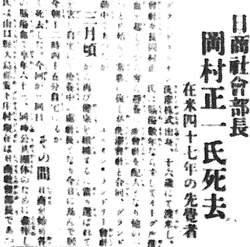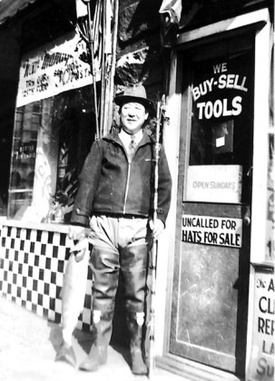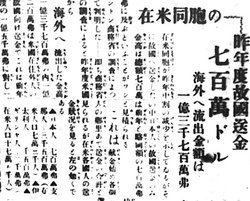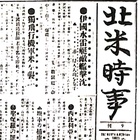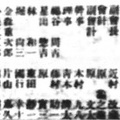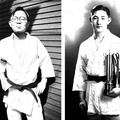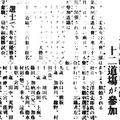Notable Activities and Obituaries of People from Yamaguchi Prefecture
1. Seiichi Okamura from the Agenosho village in the Oshima disctrict
“Department Chief of Nissho, Japanese Business Association, Seiichi Okamura Passes Away” (June 28, 1939 issue1)
The president of Grand Union Laundry Corporation, Seiichi Okamura, had recovered from a cerebral hemorrhage after having taken some rest and had been working full-time. He, however, fell ill again around March. He had been under treatment at home, but he passed away at home at 12:45 a.m. today. It was his third cerebral hemorrhage. He was 63.
Okamura was from the Agenosho village in the Oshima district in Yamaguchi Prefecture, moved to the U.S. at age 16, and became the manager at Eagle Laundry Company in less than a few years. The company merged with another laundry company. Upon the establishment of Grand Union Laundry Corporation, he was chosen to become the president and has served the role until the end of his life. During those years, he has also contributed to a number of public organizations including Nissho, and was the department chief at Nissho-shakai. He was a person of integrity, a rare individual with a peaceful mind and good fortune.
“Attendees Filled Hall at Okamura’s Lavish Funeral” (July 3, 1939 issue)
The funeral of Mr. Seiichi Okamura of Grand Union Laundry Corporation was held two days ago on Saturday from 8 p.m. at a Buddhist church . . . . Mr. Kikuzo Ueminami led the ceremony, as Mr. Yoriaki Nakagawa read the brief biography of the departed, and condolence messages were given by a representative of friends, Mr. Sokichi Hoshide, the representative of Waseda Baseball Club, Mr. Arthur Sasaki, the representative of the Japanese Laundry Industry Union, Mr. Tsunejiro Iwana, the representative of Dry Cleaners Union, Mr. Masaru Imamura, the representative of Yamaguchi Junior Club, Mr. Jiro Aoki, the representative of the Buddhist church, Mr. Yasuzo Inoue, the representative of the Yamaguchi Kenjinkai Overseas Association, Mr. Kaizo Chikamura, and Mr. Genji Mihara the representative of Nissho . . . . Mr. Chuzaburo Ito gave a speech of gratitude. With nearly 500 attendees, it was quite a lavish funeral we haven’t seen lately.
Mr. Seiichi Okamura succeeded the position of the Yamaguchi Kenjinkai president from Mr. Chuzaburo Ito, and was actively working as the department chief of the Nissho-shakai. A report from the Ministry of Foreign Affairs shows that Grand Union Laundry Corporation, which was run by Mr. Seiichi Okamura, had 120 employees in 1913 and made 115,000 dollars in sales (230,000 yen back then and about 230 million yen at the current rate).
2. Ryunosuke Yoshida from the Kaminoseki village in the Kumage district
As written in the previous chapter, Jim Yoshida’s father Ryunosuke Yoshida served as a committee member of the judo dojo “Tentokukan” and director of the Yamaguchi Kenjinkai. The photo with Ryunosuke Yoshida catching a big salmon was what my father Atae had in his belongings, and is estimated to have been taken around 1938.
“Ryunosuke Yoshida Passes Away” (December 20, 1939 issue)
Mr. Ryunosuke Yoshida, a person from Yamaguchi Prefecture, has been engaged in barbershop and laundry businesses at Grand Central Hotel, and he passed away this morning at 4 a.m. from angina pectoris.
Next to this article was an ad by Katsumi Yoshida (Jim Yoshida’s Japanese name) letting readers know that the details of the funeral would be informed once decided. The story of the passing of Mr. Ryunosuke Yoshida was written in detail in The Two Worlds of Jim Yoshida.
“Information about the Funeral of Mr. Ryunosuke Yoshida” (December 23, 1939 issue)
Funeral: December 27 at 7:30 p.m. at Buddhist Church. Chief mourner is Katsumi Yoshida; relatives from Japan are Saisuke Yoshida, Atae Shinmasu; a representative of friends is Chuzaburo Ito.
My father, Atae, heard about the passing of his uncle Ryunosuke and wrote how much he was saddened by the news. Atae attended the funeral as one of the family members.
“Funeral of Late Ryunosuke Yoshida” (December 28, 1939 issue)
The funeral of late Ryunosuke Yoshida was held at the Buddhist church last night from 7:30 p.m. It was quite a lavish funeral with 260 attendees. A countless number of tribute flowers were placed in front of the Buddhist altar, including those from various organizations. After Missionary Ichikawa’s reading of scriptures, everyone offered incense, and a brief biography was read, followed by the reading of condolence telegrams by Eihan Okiyama and speeches by a representative of friends, Chuzaburo Ito; Barbershop Union, Jitsuzo Hara; a representative of Laundry Union, Tsunejiro Iwana; a representative of parents from Tentoku-kai, Kazuo Kawafune; and the Yamaguchi Prefecture Overseas Association, Kaizo Chikamura. As a representative of the bereaved family and relatives, Shunichi Yoshida gave a speech of gratitude. A commemorative photo was taken after the ceremony, and the funeral service ended at 9:30 p.m.
Sending Money to Home Country
Many Japanese who immigrated overseas sent most of their earnings to their hometowns. For Japanese people, sending money to their families in need in Japan was their first priority.
“Hiroshima Sends Observers of Immigrants to the U.S.” (January 17, 1918 issue)
It’s a well-known fact that Hiroshima Prefecture has sent the most immigrants abroad among all the prefectures. Within Hiroshima Prefecture, Niho village of Aki district is said to be the top. As of now, the number of immigrants overseas from the village includes 3,350 in Hawaii, 850 in North America, 730 in South America, and 160 in Qing dynasty and South Seas Mandate, totaling to [a] large number of over 5,000; the amount of money that was sent from those immigrants to Japan added up to 200,000 dollars on average annually (about 400,000 yen back then and an equivalent of about 400 million yen at the current rate). Given that the Niho village’s population was 19,500, two people from each household were sent abroad on average.
To observe the situation of immigrants overseas from NIho village as well as to visit those courageous fellows who have been working so hard for many years in a foreign land, assistant official Tadashi Hamai from the village has been appointed to visit North America. He left his home on October 22 last year and arrived in Honolulu on November 5 . . . . He will visit San Francisco and Los Angeles, and then move north to visit Portland and the Seattle area.
According to Hokubei nenkan 1928, the Japanese residents in the U.S. sent 14 million yen (about 14 billion yen at the current rate) to their home in 1925, and Hiroshima Prefecture received 1.7 million yen (about 1.7 billion yen at the current rate) and Yamaguchi Prefecture received 990,000 yen (about 1 billion yen at the current rate).
“Japanese Residents Sent Seven Million Dollars Home Last Year” (March 15, 1940 issue)
A report from Washington State Department of Commerce revealed that the amount of money that Japanese residents in the U.S. sent home last year added up to 7 million dollars. According to their research, the total money that [was] sent out of the U.S. last year was 137 million dollars. Out of that, 102 million dollars were sent from foreign residents in the U.S. to their home countries (this was a total of the money transferred by individuals to their home, including donations). While it was 10% less than the 150 million dollars from the year before, only the money transfer by the Japanese to their home is estimated to be the same as the year before, totaling to 7 million dollars.
The amount of money transferred by people from each of their home countries is as follows: 7 million dollars by the Japanese, 35 million dollars by the Chinese, 15 million dollars by the Italian[s], 20 million dollars by the Greeks, 4 million dollars by Swedes, 2 million dollars by the Norwegians, 11 million dollars by the Irish, 2 million dollars by Finns . . . 30 million dollars out of the total 100 million dollars of the money transfer mentioned were said to be sent by postal money order.
According to this article, the total amount of money transfer to Japan from the Japanese residents in the U.S. was 7 million dollars in both 1938 and 1939, which was about 25 million yen back then and about 25 billion yen at the current rate. We can see that the immigrants in America were making significant contributions to Japan.
It is clear that the Japanese residents in Seattle had a strong sense of attachment to their home prefectures and were highly committed to contributing to their local communities as shown in their money transfer and support when disasters occurred.
In the next part, I will write about the activities of the Nihonjin-kai that supported the Japanese residents in Seattle.
*Excerpts from articles include summaries from the original text.
Note:
1. All article excerpts are from The North American Times unless noted otherwise.
References:
Jyushiro Kato, History of Development of Japanese in the United States, Hakubun-sha, 1908.
Hokubei-nenkan, Hokubei jijisha, 1928.
Edited by Zaibei nihonjin-kai jiseki hozonbu, History of the Japanese in the U.S., Zaibei nihonjin-kai in the U.S., 1940.
Jim Yoshida and Bill Hosokawa, The Two Worlds of Jim Yoshida, Bunka Publishing Bureau, 1977.
*The English version of this series is a collaboration between Discover Nikkei and The North American Post, Seattle’s bilingual community newspaper. This article was originally publishd in Japanese on October 31, 2022 in The North American Post.
© 2022 Ikuo Shinmasu


